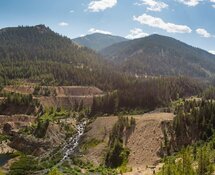Tom MacNeill: The recent pullback is perfectly healthy. The entire world is trying to competitively devalue currencies because it's the only way to get out from under the debt burden created by liquidity added to the capital markets over the last three years.
We don't expect that the gold price is going to come down anytime soon. Either the international community has to keep adding liquidity, which is good for the price of gold, or it achieves economic development, which will create severe inflation, also good for the price of gold.
The game isn't done yet. It will still take a few more years to see where macroeconomic policy takes us. I believe that we will have an upward-slanting chart through 2012 with some hiccups. When it gets ahead of itself, like all parabolic charts do every now and then, it will be painful for some in the short term.
From a gold developer's perspective, what more could you ask for than $1,700/ounce (oz) gold and the ability to contain cash costs because there is economic pressure downward in the cycle? It's good news for gold developers.
TGR: So it's the best of both worlds?
TMN: Yes, at least for the next couple of years until the world sorts itself out macroeconomically. There's going to be a point in the future to exit most gold positions, but not likely in the coming year.
TGR: What other metals do you believe are poised to perform in 2012?
TMN: Historically, there have been times where gold leads the base metals. If consumption demand picks up, the price of gold will fall off. However, as an industrial metal, copper's price likely won't fall off because it will be in even higher demand. China already consumes half the world's copper. We are still in the early days of the copper cycle.
When most investors were running away from base metals a couple of years ago is when we were getting our feet wet developing cheap projects. Our No. 1 and No. 3 projects right now are gold and copper projects.
TGR: Have you noticed increasing competition for early-stage dollars?
TMN: We're contrarians. We get involved in projects when commodity prices drop, investors are running away and companies can't raise capital. By the time most players want to throw capital at copper companies, we've likely already made our seed investments and are moving assets forward at that stage. We don't find competition because we run counter to the herd. There should be a lot of activity in early-stage copper exploration over the next 12 months, but we won't have much interest in competing for those investments because we are already developing assets that we acquired one to three years ago.
TGR: What are some names that are off to a good start this year?
TMN: We're most excited about DNI Metals Inc. (DNI:TSX.V; DG7:FSE). It was up 45% in January alone and was just added to the TSX Venture 50. We have very high expectations. We own about 15% of the company and will continue to fund it as it moves forward.
Tembo Gold Corp. (TEM:TSX.V) is about to be listed on the Toronto Venture Exchange within a couple of weeks. The company has three drill rigs ready to explore its property in Tanzania.
Westcore Energy Ltd.'s (WTR:TSX.V) stock hasn't performed yet, but it has $3 million (M) in the till and it is just starting a thermal coal drill program near the Saskatchewan-Manitoba border for heavy crude conversion.
Batero Gold Corp. (BAT:TSX.V)—love that one. It's right on the verge of developing its first NI 43-101 resource calculation of a Colombian multiple porphyry project that we're very excited about. We're passive investors in Batero but we've loved it since day one. It's a very interesting story.
TGR: DNI just released a resource study on its Buckton mineralized zone in Alberta, a black shale play that has rare earths and other metals.
TMN: The project keeps getting bigger and better. DNI recently released an Inferred resource of 250 million tons (Mt) with a suite of metals including nickel, molybdenum, lead, zinc, vanadium and uranium. It's a large-scale, low-grade base metals deposit. The in situ value of this suite of metals appears to be between $20 and $25/ton (t). That gets my attention immediately. It also appears that the value of rare earth elements is about $50/t of rock combined. The real value in the collective recovery of all these metals together is enormous.
We expect DNI has in excess of 2 billion tons of material—there are 250 Mt with just the preliminary resource estimate based on a very small component of the zone. That's potentially a $150 billion (B) in situ resource.
Buckton is an analog to the Talvivaara mine in Finland, which went into production in 2010. It's a low-grade nickel deposit with a suite of other minerals that add up to a rock value of between $60 and $80/t with about 1.5 Bt of resource worth about $116B. Similar to the Finnish project, DNI's bioleaching uses organisms within the shales for recovery, which means it's a very "green" project.
TGR: Have there been any metallurgical tests done on Buckton?
TMN: There have been a series of them done in Canadian and French laboratories for confirmation with recoveries that run from 50–100% in the suite of minerals and REEs. The next phase is to develop a small pilot plant to prove minerals can be economically liberated out of the shales and overburdens. Given similar projects in the oil sands for metals recovery from tailings, we expect it will cost somewhere between $20M and $40M to prove economic viability.
TGR: What's the timeline for a preliminary economic assessment (PEA)?
TMN: The PEA could be completed by the end of this year. However, the company is going to need to build the small pilot facility, which likely could be completed sometime in 2013.
TGR: One of your top 10 holdings is Batero, which should be releasing a resource estimate on the Quinchía project in Colombia soon. What are you expecting from that?
TMN: Very good things. We're passive investors, but we will likely be adding to our position based on the results of the NI 43-101. Quinchía is potentially a world-class project. It's in the same structural trend of other 10+ million ounce (Moz) gold deposits.
Batero is drilling three related projects, with most of its activity on the La Cumbre porphyry. They consistently hit near surface mineralization that so far extends over intersections as long as 750 meters. It is open in all directions. It's a perfect world for a very good deposit: consistent, low grades running between 0.5 and 1 gram per ton (g/t), which is imminently mineable in this current pricing environment; huge size; an oxide zone at the top of the La Cumbre, which could potentially be higher grade; and an area that shows a hydrothermal system that could be very high grade.
All of that is on only half of the property. The other half of the property hasn't even had a lot of basic geophysical and geochemical work done for exploration.
My expectation is Batero should come close to or exceed 5 Moz of gold with a grade somewhere between 0.50 and 0.75 g/t in the current NI 43-101.
One of the most successful mines in the world is the Marigold mine operated by Goldcorp Inc. (G:TSX; GG:NYSE) and Barrick Gold Corp. (ABX:TSX; ABX:NYSE) in Nevada. It has 1.5 Moz with a 0.61 g/t grade. The project made $30M in net profit in 2010 on about $100M in gold sales. And that's a fifth of the size of the potential initial resource calculation on Batero's project in Colombia.
On the back of Batero's resource calculation, I suspect that it will become a target of senior miners that are having a tough time replacing depleted ounces on the books.
TGR: Tembo Gold has a project in the Lake Victoria Greenstone Belt in Tanzania not far from where African Barrick's Bulyanhulu mine exists. There have been some issues in Tanzania with artisanal miners. Do you expect that to be a problem for Tembo as it has been for African Barrick Gold Plc (ABG:LSE)?
TMN: I don't think so. It's really only been a problem for African Barrick at certain projects and not to my knowledge at Bulyanhulu. I don't think the artisanal miners will be a problem. The country has a very stable mining law, a modern mining act and licensing system. I expect the government will help deal with artisanal miners in a non-confrontational way because, like all governments, it wants royalty revenue from commercial operators.
We made our first investment in 2007 into Lakota Resources, which is the predecessor of Tembo, because we just love the project. It's one of the best early-stage gold exploration projects in Africa right now. The predecessor company suffered from a number of headwinds and management hiccups. We took the company in-house to deal with the management and capital structure issues and put it back together again. Now the training wheels are off.
There are about 2,000 artisanal miners mining gold on the Tembo property right now. They've got hundreds of pits and shafts dug out with chisels, picks and shovels that are producing grades as high as 0.8 oz/t. There's clearly already a gold mine there. Tembo is mobilizing three drill rigs on the property and is going to spend between $15–25M in the next 12–18 months to prove the existence of a modern, commercial gold mining enterprise as opposed to rudimentary mining activity.
We will be adding to our position once it is publicly traded.
TGR: The company could be a takeover target of Barrick. Is Barrick already an owner?
TMN: Possibly. Barrick never has to buy anybody in its neighborhood, but it's pretty obvious that it could be a candidate if Tembo defined a significant resource.
TGR: Your top holding is a private company, Newsk Emerging Resources Ltd.
TMN: Newsk is a holding company with an investment in CVG Mining, a private gold exploration company in British Columbia. We've been supporting it through equity and debt financings as it develops.
It's an exciting, but technically challenging project because it's 165 feet beneath a river in an underground alluvial deposit. CVG has rehabilitated old ramp workings and run a full scale freeze plant. It drilled 15 freeze holes across the river channel, froze the ground and is currently starting a bulk-sample excavation project to determine the actual grade.
The viability of the project could be established in this quarter. We have high expectations because over 100 drill holes put into the project over the last 50 years indicate that there is high-grade coarse gold trapped in the alluvial gravel at the bottom of that channel. The Cariboo mining district in British Columbia is historically the richest alluvial gold bearing area, per mile, in the world.
TGR: If its project is viable, is the company likely to go public?
TMN: Probably, because it will need to raise development capital. There are groups waiting in the background for the results of the feasibility work. CVG's Wingdam project should be robustly economic at any grade over 0.25 oz/t even with the technical challenge of mining wet unconsolidated material underground.
TGR: What public company that you cover could be the top performer this year?
TMN: Either DNI Metals or Batero Gold. It is a bit of a horse race! Given that Batero is on the verge of its first and likely significant resource calculation, it should do very well shortly. DNI, given the potentially very large scale, should also perform well this year.
Batero is going to be eyeballed by every resource producer in South America and beyond if the resource calculation comes in the way I expect. In that case, I anticipate a large investment by a senior mining group and the stock price could triple or quadruple in 2012.
TGR: This space got off to a good start in 2011, but couldn't have finished much worse. What are your thoughts on the junior commodity sector going forward?
TMN: There was a lot of money raised in 2008 for companies that shouldn't have gotten it in the first place. Those companies have been able to limp along and they're finally dying. After a resource down-cycle—and 2008 was such a violent one—a bunch of companies die. They're delisted. They go away and people forget about them. That didn't happen this go-around. There were hundreds of companies with enough in the till to pay the executives and limp along hoping for something good. That confused retail investors, who just saw a company with a couple million dollars in the till and assumed it had some potential. However, most of them didn't. They got that money just because there was a lot of loose capital in 2008 that caused this cycle to drag on longer.
It's normal for the industry to rationalize and for companies to dissolve. Investors need to look at who is left standing and realize it is always the good management groups. They're well capitalized. They've got good projects. There has been too much noise for the last couple of years that confused investors even further.
Investors are more objective this year. They're a little bit smarter after losing money. There's an old adage on Wall Street that nobody ever went broke taking a profit. Investors are more tempted to take profits because they don't like the feeling of having a stock that they bought at $0.50/share go to $5/share then fall to $0.30/share. This new comfort with selling resource equities is a healthy thing because it gives investors capital to reinvest in new projects and smoothes the cycle by tempering speculation.
That's exactly what we do at 49 North. We are not afraid to liquidate positions so that we can move it back to the beginning of the food chain. That creates a healthy capital environment for junior resource explorers. We're moving into that phase now.
Macroeconomically, things are not going to be hard for resource investors. To be sure, they will be volatile. But it will be very lucrative for patient investors who are objective.
TGR: Thanks for sharing your thoughts, Tom.
Read more of Tom MacNeill's energy investing ideas in The Energy Report.
Tom MacNeill established 49 North Resources Inc., an incubator fund to raise capital for early-stage projects to develop resources throughout Saskatchewan in 2006; he serves as president, CEO and director of the company. His 25+-year career includes positions as an investment advisor with a major Canadian brokerage firm, management accountant within the mining industry, CFO of a Canadian trust corporation and extensive resource portfolio management.
Want to read more exclusive Gold Report interviews like this? Sign up for our free e-newsletter, and you'll learn when new articles have been published. To see a list of recent interviews with industry analysts and commentators, visit our Exclusive Interviews page.
DISCLOSURE:
1) Brian Sylvester of The Gold Report conducted this interview. He personally and/or his family own shares of the following companies mentioned in this interview: None.
2) The following companies mentioned in the interview are sponsors of The Gold Report: DNI Metals Inc., Tembo Gold Corp., Goldcorp Inc., 49 North Resources Inc. Streetwise Reports does not accept stock in exchange for services.
3) Tom MacNeill: I personally and/or my family own shares of the following companies mentioned in this interview: Westcore Energy Ltd., Tembo Gold Corp., DNI Metals Inc., 49 North Resources Inc. I personally and/or my family am paid by the following companies mentioned in this interview: 49 North Resources Inc. I was not paid by Streetwise for participating in this story.










































